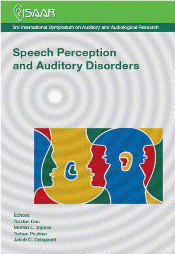Spatial cue reproduction in modern receiver-in-the-ear hearing instruments
Abstract
This study investigates the ability to preserve spatial cues in receiver-in-the- ear (RIE) instruments for six different hearing aid manufacturers. In this particular study, the instruments were fitted bilaterally assuming a symmetric hearing loss profile. In cases where the manufacturer recommended a specific programming option to maximize spatial awareness, this option was chosen. Otherwise, the default mode was applied. S2 and N4 audiograms were used to mimic hearing-loss and testing was performed in an anechoic chamber on a KEMAR head. In order to mimic the peripheral filtering of the auditory system the left and right signals were filtered using a gammatone-filterbank. ILD's were estimated at the output of each band across angles from 0-360 degrees and compared to the corresponding values of the open-ear-response. ITDs were determined by low-pass filtering the left and right input signals and using a cross- correlation technique in order to find their respective time shift. Distortions of ILDs were as large as 10 – 15 dB for certain manufacturers whereas ITD distortions lay between 20-100 μs.
References
Bronckhorst, A. W. and Plomp, R. (1989). “Binaural speech intelligibility in noise for hearing impaired listeners” J. Acoust. Soc. Am., 86, 1373-1383.
Glasberg, B. R. and Moore, B. C. J. (1990). “Derivation of auditory filter shapes from notched-noise data” Hearing Research, 47, 103-138
Hartmann, W. M. and Wittenberg, A. (1996). “On the externalization of sound images“ J. Acoust. Soc. Am., 99, 3678-3688.
Hartmann, W. M., (1999). “How we localize sound“ Physics Today, 52 (11), 24-29. Hawley, M. L., Litovsky, R. Y. and Culling, J. F. (2004). “The benefit of binaural hearing in a cocktail party: effect of location and type of interferer” J. Acoust. Soc. Am., 115, 833-843.
Raspaud, M., Viste, H. and Evangelista, G. (2010). “Binaural source localization by joint estimation of ILD and ITD“ IEEE Transactions on Audio, Speech and Language Processing, 18, 68-77.
Van den Bogaert, T., Klasen, T. J., Moonen, M., Van Deun, L., and Wouters, J. (2006). “Horizontal localization with bilateral hearing aids: Without is better than with” J. Acoust. Soc. Am., 119, 515-526.
Additional Files
Published
How to Cite
Issue
Section
License
Authors who publish with this journal agree to the following terms:
a. Authors retain copyright* and grant the journal right of first publication with the work simultaneously licensed under a Creative Commons Attribution License that allows others to share the work with an acknowledgement of the work's authorship and initial publication in this journal.
b. Authors are able to enter into separate, additional contractual arrangements for the non-exclusive distribution of the journal's published version of the work (e.g., post it to an institutional repository or publish it in a book), with an acknowledgement of its initial publication in this journal.
c. Authors are permitted and encouraged to post their work online (e.g., in institutional repositories or on their website) prior to and during the submission process, as it can lead to productive exchanges, as well as earlier and greater citation of published work (See The Effect of Open Access).
*From the 2017 issue onward. The Danavox Jubilee Foundation owns the copyright of all articles published in the 1969-2015 issues. However, authors are still allowed to share the work with an acknowledgement of the work's authorship and initial publication in this journal.


